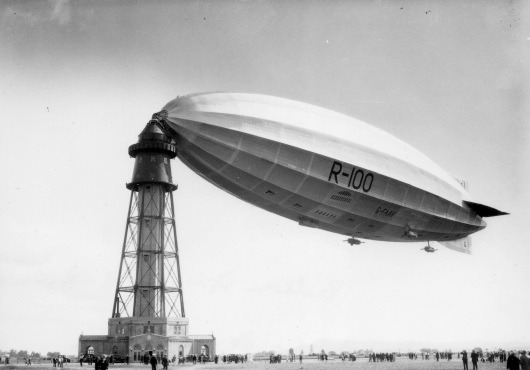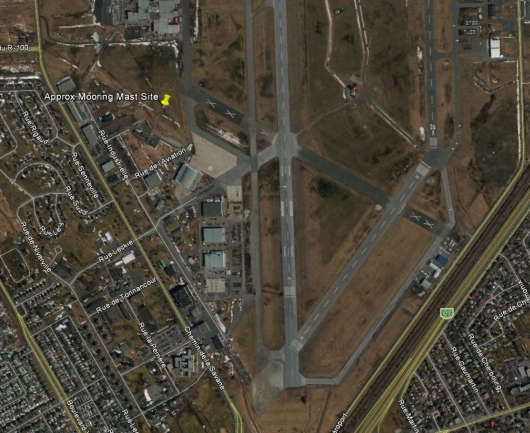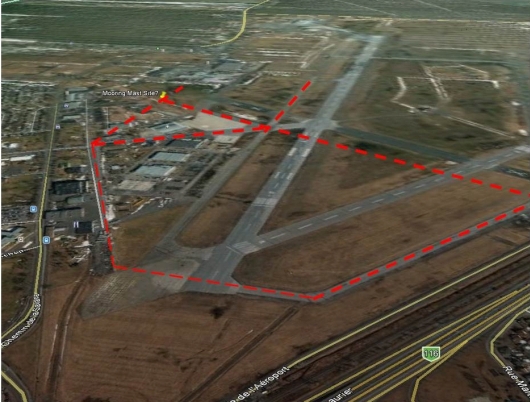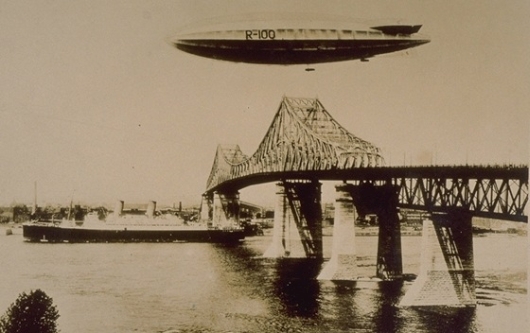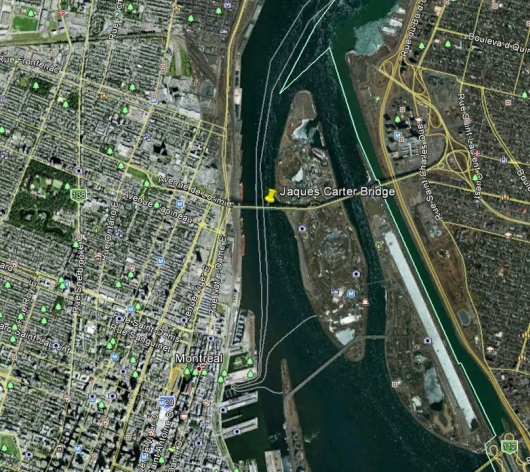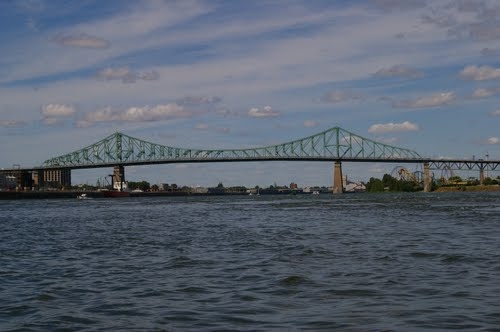British R-100
Jump to Sites of Interest: Saint-Hubert, Quebec, * Jacques Carter Bridge in Montreal * Toronto, Ontario * Kingston, Ontario
Photo credit: Undetermined
The R-100 was one of two British rigid airships completed in 1929 as part of a British government program to develop civil airships capable of servicing long-distance routes. The R-100 was designed and built by private company, the "Airship Guarantee Company", under government contract, while the R-101 was designed and built by a team appointed by the Air Ministry. The R-100 was just under 720 feet long, but when completed, the R-101 was the world's largest airship, at 777 feet long, and it was not surpassed until the Hindenburg flew five years later.
Construction
R100 was built by the Airship Guarantee Company, at the Royal Naval Air Service (RNAS) Air Station near Howden, in Yorkshire, UK. (Absolutely nothing is left of this Air Station, as it was closed in 1930 after the fatal flight of the R-101. The entire Air Station was apparently demolished and returned to farmland). For construction details see Wikipedia and other on-line sources.
Operations
The R-100's first flight was on 16 Dec, 1929, when she flew to Cardington to participate in demonstration flights for the Air Ministry to determine which of the two airships, the R-100 or the R-101 was better. Upon successful trial flights, the R-100 was committed to a long duration transatlantic flight to Canada, which she completed successfully from 29 Jul to 16 Aug, 1930. History seems to indicate that the extremely successful flight of the R-100 to Canada and back put enormous pressure on the Air Ministry to approve an early flight of the R-101 to India. Of course, on that flight to India, the R-101 crashed. The crash of the R-101 in Oct, 1930, grounded the R-100.
Demise
When the R-101 crashed, it put an enormous stigma on airship operations. The UK Air Ministry halted all Airship operations until they determined a course of action. The R-100 was hangared and deflated after the R-101 crash, and the Air Ministry studied for a year, three possible options: Retrofit the R-100 for continued operation; static testing (no flights); or scrapping the airship program. The decision was made in November, 1931 to end the Airship program.
Ignominious End
The entire handcrafted metal framework of the R-100 was dismantled, crushed by steamrollers and sold for less than £600 - under $3000 US at 1931 exchange rates. She had cost £450,000 (about $2.225M US).
Sites of Interest
Airport, Saint-Hubert, Quebec, Canada
The photo above of the R-100 was taken at the Mooring Mast at the airport in Saint-Hubert, Quebec, Canada. Canada was one of the sites for planned routine stops for British Airship Service. Obviously, after the British decision to end the airship program after the crash of the R-101, the Canadian mooring mast was demolished.
Photo credit: New York Times
I was able to determine the approximate location of where the mast once stood, with the help of a terrific map from airshipsonline.com, and Google Earth. I provide this photo of the Saint-Hubert area, where the Airport still exists, the way it looks today, with a map tack marking the mast location. (Note: Thanks to a comment from Bob (see comment below), I found my mast location was only 177 feet from the actual mast location! See "Mast Location Update" below):
Photo credit: Google Earth
The location of the map-tack in the photo above is (Lat Lon) 45.520192 -073.423169, (Click here to View in Google Maps), and is the best location I could determine where the mast once stood.
The rationale for thinking the Mooring Mast was at this Lat/Lon is from this next photo (at left). (Look closely and you can see an airship, probably the R-100, at the mast), and the map to its right:
Photo credits: (Left) National Aviation Museum Photo Essay Collection.
(Right) http://www.airshipsonline.com/sheds/Canada.htm
When compared to this view of the Saint-Hubert Airport today, from low altitude, at an oblique angle in Google Earth, the runways make a very close match to the 1930 photo above:
Photo credit: Google Earth
You can see the striking visibility of the current runways/taxiways, and roads! In fact, "De La Savane Road" in the map, still exists as "Chemin de la Savane" and the "Canadian National Railway" track still exists right next to what is today the "Boulevard Sir-Wilfrid-Laurier", route 116. I'm pretty sure my location for the mast is pretty close to the actual site!
Mast Location Update!
Reader Bob showed me an incredible observation! If you look to the right of my mast marker, you see an area of grass somewhat different in color from the surrounding grass. This spot of grass just so happens to fit the outline of the foundation of the original mast! So here is an overlay image so you can visualize the mast location by this grassy spot (click/touch the blue bar and slide the divider left-right to reveal the mast location):
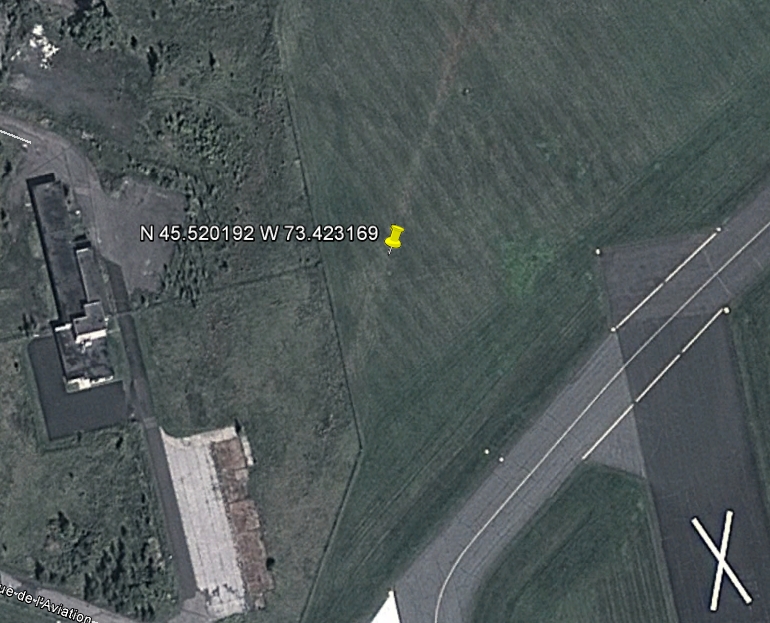
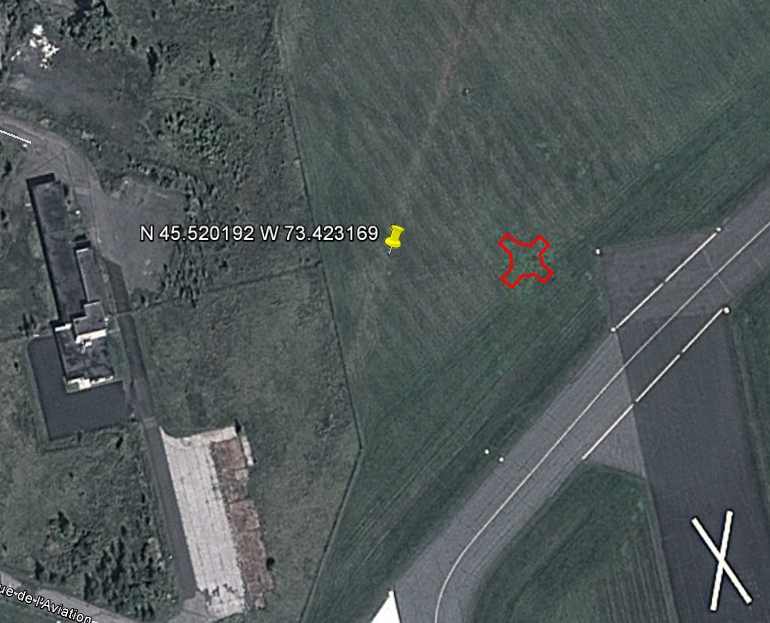
Photo credits: Google Earth
The location of the mast was actually (Lat Lon) 45.520155 -073.422478, just 177 feet to the right of my estimate! (The red boundary in the overlay is not intended to be an "exact" fit to the grassy spot, but it is only to aid the viewer in locating the area.)
Jacques Carter Bridge in Montreal
Next this next photo shows the R-100 over the Jacques Carter bridge in Montreal in 1930:
Photo credit: Undetermined
This was much easier to find than the mooring mast:
Photo credit: Google Earth
The location of the map-tack for the Jaques Carter Bridge in the photo above is (Lat Lon) 45.521775 -073.540953, (Click here to View in Google Maps).
And finally, this next photo shows the Jaques Carter Bridge today:
Photo credit: Undetermined

